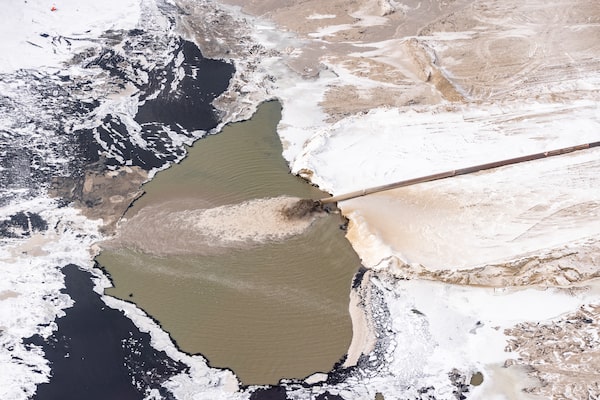
The Alberta Energy Regulator slapped Imperial Oil with a non-compliance order and an environmental protection order over toxic tailings water that has been seeping from the Kearl oil sands site in northern Alberta.Nicholas Vardy/Handout
Toxic tailings water that has been seeping for months from the Kearl oil sands site in northern Alberta into the environment underscores a broader problem about the patchwork of federal and provincial laws that govern the sector, experts say.
And they say a lack of communication and transparency has eroded public trust in Alberta’s energy regulator.
Water tainted with dangerous levels of arsenic, dissolved metals and hydrocarbons has been leaking off the Kearl project onto Crown lands since May, and last month a drainage pond at the site overflowed, spilling an estimated 5.3 million litres of industrial wastewater laced with pollutants. But, as reported in Thursday’s Globe and Mail, the Athabasca Chipewyan First Nation downstream from the site says it was kept in the dark about the extent of the problem.
The Alberta Energy Regulator slapped Imperial Oil Resources Ltd. IMO-T with a non-compliance order and an environmental protection order over the incidents. The Calgary-based company has since submitted plans for containment, monitoring and remediation of the land and waterways.
Kristen van de Biezenbos, associate professor of energy law at the University of Calgary, said there is a lack of co-ordination between the AER and enforcement at a federal level, despite overlapping authority.
“The result is a system full of holes that companies like Imperial can exploit to the detriment of First Nations and other people living in northern Alberta,” she said in an interview.
While she thinks it’s likely that the toxic tailings seepage and the February spill violated environmental laws, she said Alberta and Ottawa are routinely inconsistent in enforcing their own regulations, which has in turn “created an environment of distrust” between First Nations and government.
“That is a serious problem that really needs to be repaired,” she said. “Both levels of government need to think carefully about, ‘What message are you sending to First Nations and rural communities when you refuse to hold companies to their legal obligations?’ ”
Environmental law professor Martin Olszynski isn’t surprised about the seepage, saying it has been raised as a problem for years. For example, a 2020 report from the Commission for Environmental Cooperation, an international collaboration between Canada, Mexico and the United States on environmental issues, found “scientifically valid evidence of [oil sands] seepage into near-field groundwater around tailings ponds.”
Still, the situation at Kearl “confirms all your worst fears,” he said.
Like Ms. van de Biezenbos, he said there is no functional relationship between provincial and federal watchdogs, which means problems can fall through the cracks.
On top of that, Ms. van de Biezenbos and Mr. Olszynski believe the AER has eroded its own reputation because of a lack of transparency.
“They’ve given every reason not to trust that they have their eye on the public interest,” Mr. Olszynski said.
The AER pointed to a statement on its website that the investigation is continuing. The regulator said it is “always looking for opportunities to modernize our requirements and make them more effective, as well as improve relationships and engagement with Indigenous communities. If this event highlights an opportunity to do so we will pursue it.”
Federal Environment Minister Steven Guilbeault told The Globe in an e-mail Thursday that he was “deeply concerned” about the situation at the Kearl oil sands site, and the potential impact on the health and well-being of families in Athabasca Chipewyan First Nation and other Indigenous communities.
His department is responsible for enforcement of the pollution prevention provisions of the Fisheries Act, which prohibits the deposit of harmful substances into water frequented by fish.
Mr. Guilbeault said officials from his department are in contact with the AER, and that federal enforcement officers “will be given all resources necessary to continue their independent assessment, under the jurisdiction of the federal Fisheries Act, to determine next steps.”
The problems at Kearl also concern the president of Canadian Natural Resources Ltd., which has operations in Alberta’s oil sands, but for different reasons.
“In every industry, when you have an issue, the media reports on it and then all companies within that industry are indirectly impacted,” Tim McKay said. “Whether it’s a safety incident or environmental incident, you really don’t want any of them – no matter which industry you’re in.”
Athabasca Chipewyan First Nation Chief Allan Adam told media at a press conference Thursday that he believes it was “environmental racism” for the AER and Imperial Oil to keep his community in the dark about the toxic tailings seepage.
And he said both the oil company and the regulator would have treated communication differently and told people what was going on had it happened near a larger population centre.
“But because we are small communities, small First Nations living up north, we’re not considered to be … human, I guess,” he said.
Imperial Oil’s vice-president of oil sands mining, Jamie Long, said in a statement that the company works hard to maintain transparent communication, and recognized Athabasca Chipewyan’s concerns about delays in receiving additional information.
“As mentioned by Chief Adam, we have expressed to him directly our regret that our communications did not meet the expectations of the ACFN community, we further committed to him that we are taking the necessary steps to improve our communications so this does not happen again in the future,” Mr. Long said.
Mr. Long said based on monitoring to date, “there is no measurable impact to local waterways, or reported impacts to wildlife.” He added that any risk to the public is extremely low.
Mr. Adam said most of the Athabasca Chipewyan population hunt, fish or collect plants from the land. The First Nation has started a contamination-testing program for anything harvested since May.
Alberta’s United Conservative government said it couldn’t comment while the arm’s-length regulator was investigating.
 Emma Graney
Emma Graney